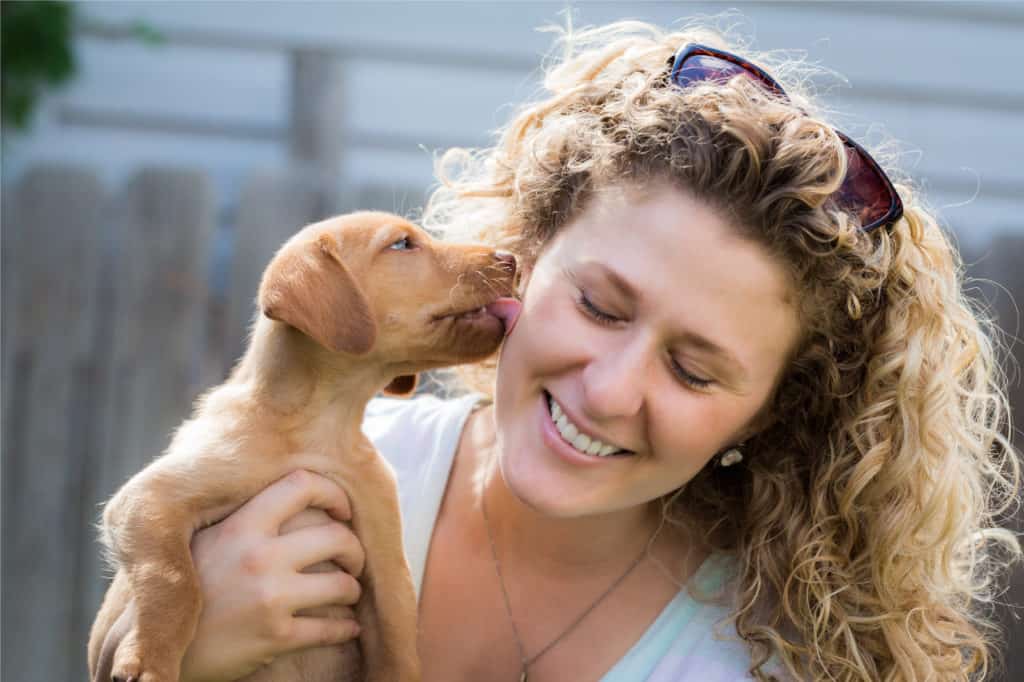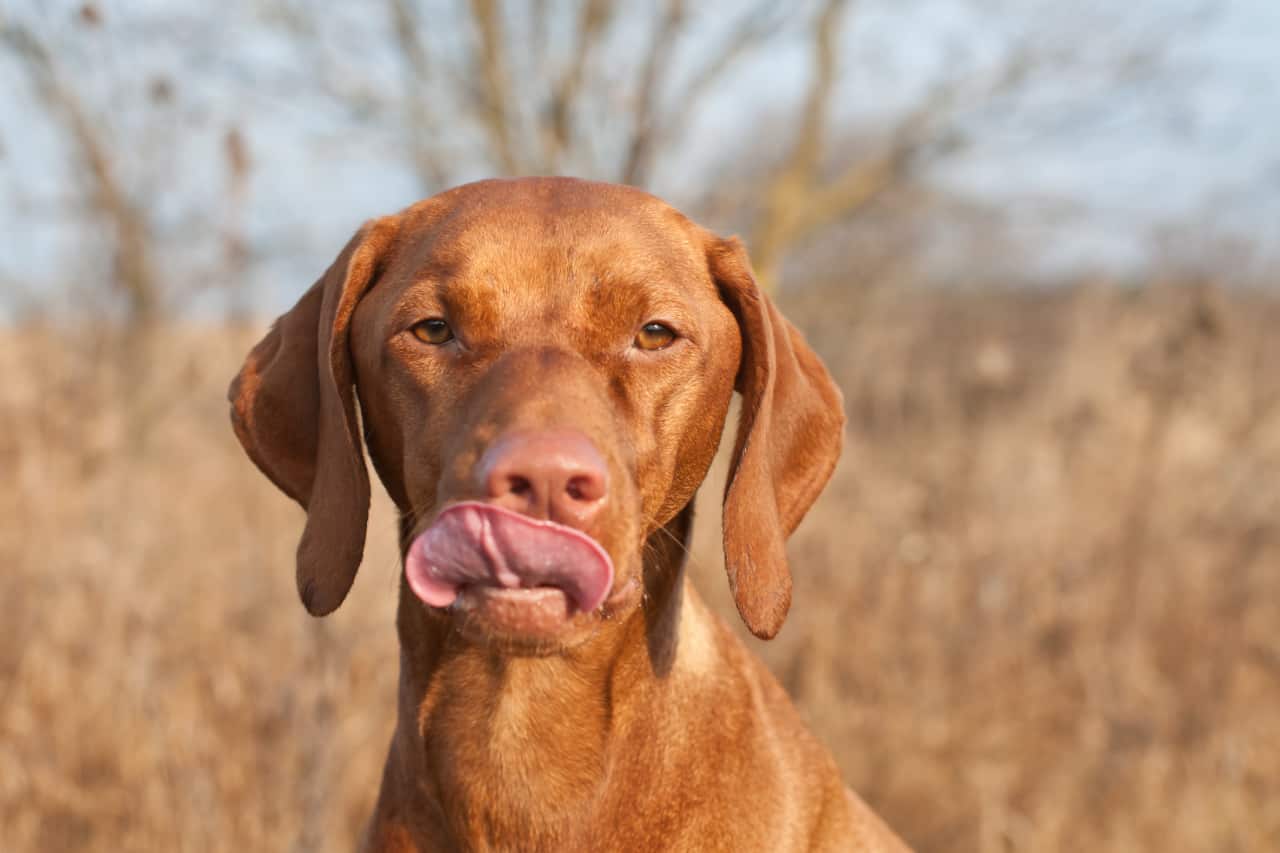There is nothing better for some dog lovers than getting a great big slobbery kiss from their canine companion. For other people, even dog lovers, a wet smooch from a Vizslas makes them cringe away in horror. Neither person is right nor wrong; it is merely a matter of personal preference.
Dogs lick humans for different reasons:
- Healthy social behavior
- Unintentional behavioral reinforcement by the owner
- Alerting their owner to their medical condition
Understanding the underlying reason for licking allows the owner to decide if the licking is healthy and modify undesired behavior.
A dog’s desire to lick its owners or other people can be disconcerting; the recipient’s reactions range from delighted to appalled. But why are dogs motivated to lick? Understanding why a dog licks humans enables the owner to determine if the behavior is normal or not. If the tongue-washing is not acceptable, then they can develop a strategy to change it.
Vizsla Temperament
Vizslas have become known as a “Velcro” breed, an affectionate nickname coined for a dog who sticks closer than Velcro to their chosen person. Velcro dogs force their owners to bid farewell to solo bathroom trips in exchange for a constant canine companion.
A Vizsla left at home alone for long hours are more likely to develop separation anxiety or other undesirable behaviors than more independent or unsociable dog breeds.
Licking As A Normal social behavior
Dogs are social pack animals. In the absence of other dogs, Vizsla’s gladly accept humans as substitute pack mates. The breed’s close attachment to their owner results in an affectionate, visibly demonstrative dog. A wildly excited Vizsla may shower their owner in slobbery kisses. The Vizslas need plenty of human interaction with their owners and love receiving cuddles and attention.
Homecoming
Many dogs will greet each other with a quick nuzzle or lick. Dogs will similarly greet their human pack mates. A young, excitable dog who has been left on its own for long periods or who has not had an opportunity to burn off energy may go overboard with its greeting.
The Vizsla’s high-energy levels may make their affectionate behavior and playful interactions overly exuberant. Small children, animals, and frail people may find the Vizsla’s attentions overwhelming and even frightening.
Kind and sympathetic training teaches the gentle Vizsla to tone down their energy levels when interacting with others. The owner needs to help the dog learn how to calmly greet people by using different training techniques and allowing the Vizsla an opportunity to get rid of excess energy.
Submissive Behavior
Dogs may also lick each other or humans as a way to show submissiveness. Puppies and young dogs will often try to lick the mouth of an older dominant dog. Owners of dogs who lick a lot are unlikely to struggle with dominance challenges from their dog.
Excessive submissiveness can quickly devolve into anxiety-based behaviors. Anxiety may cause the dog to demand attention and reassurance from the owner, e.g., a dog who is afraid of thunder may wake its owner at night by licking them. The owner wakes up and cuddles and reassures the dog. In this scenario, the owner has become a safe place for the dog, and the dog uses licking to notify the owner that they need help.
Owners of these dogs may struggle with their dog’s being anxious. They will need to help their dog achieve a state of calm confidence without reinforcing the licking behavior.
Grooming And Play Behavior
Positive interactions are essential for forming social bonds. Like humans, dogs will groom themselves and other pack mates, e.g., a mother licking her puppies. A dog may choose to lick its human as an instinctual behavior.
Normal play behavior between dogs or between dogs and owners may drive the dog to lick the owner or other dogs. This licking is typically harmless and used by the dog to express joy and affection towards the recipient.
Accidental Behavioral Reinforcement
Owners may accidentally reinforce and encourage their dogs to lick. Puppy owners want to show affection to their new family member. They are delighted when the puppy returns their love and licks their fingers, face, or any other body part they can reach. In return, the puppy is praised and cuddled for the adorableness of the act. The puppy soon learns that a few licks will get them showered in attention.
As the dog matures and gets older, they start to get bigger and more energetic. Soon that tiny puppy tongue is a great big wet tongue. The juvenile dog leaps around, licking every part of the human he can reach. The human squeals and runs away, to which the dog thinks, “FANTASTIC, THEY WANT TO PLAY WITH ME!!!”. The next time the dog sees the person, they try the same trick, usually with the same results. The dog is encouraged to exuberantly leap around, licking everything in sight.
Establishing rules when the puppy is young is very important. The tiny pup is going to grow into a bouncing machine. It’s not fair for a dog to have one set of rules allowing specific behavior when they are young and then to have those same rules abruptly changed when they are older. Decide as a family what behavior you want or don’t want in an older dog and consistently train your puppy to follow those rules.

An Owner With A Medical Condition
Dogs’ senses are much more acute than humans, especially their sense of smell. Dogs’ sense of smell is approximately 40 times more sensitive than humans as they possess, on average, 294 million more olfactory receptors (scent detecting cells in the nose) than humans.
Dogs are attentive to their human companions. If a dog notices changes in a human’s smell or behavior, they can become curious and motivated to investigate. An untrained dog may become anxious and lick the owner to tell the owner that something is wrong, e.g., epilepsy, diabetic hypoglycemia, cancers, or wounds. Some trained service dogs use licking to alert their owner to an imminent seizure or diabetic crisis.
Tasty Skin
Dogs may like licking human skin due to the residual taste from:
- The food we touch and eat
- Lotions we put on
- The salt from our sweat
Behavioral Modification
Ruling out medical causes for the behavior allows the owner to begin training their dog not to lick. It is crucial to identify the underlying motivator for the behavior before choosing and implementing a training strategy.
Trainability
Vizsla’s are slow maturing dogs and need time and patience to become the dog the owner envisions them to be. They are intelligent and have a strong drive to please their owner. However, they are more independent than most gundog breeds and require more dedicated training than other dogs. Vizsla’s benefit from consistent training based on unwavering positive reinforcement of desirable behavior and fair enforcement of unchanging rules.
Meeting The Breeds Needs
For training to be productive, the owner needs to ensure that they meet all their Vizsla’s physical and mental energy needs. It is a waste of time trying to train a dog that is frustrated and overexcited.
Vizslas need the physical release and mental challenge of complex sports like agility, skijoring, herding, gun sports, etc., to achieve a state of attentive calmness necessary for learning. In many situations fulfilling the dog’s physical and mental needs will automatically reduce and even eliminate excessive licking without the owner having to directly address the behavior.
Anxious dogs need a calm home with consistent rules that they understand and can follow. Shouting and overly emotional behavior will often trigger anxious behavior in dogs. If the pack is unstable or bullying the dog, the dog may develop anxiety-based licking. It is best to stabilize the pack and address the bullying before “fixing” the licking.
Addressing The Behavior Directly
The undesired licking may be directly addressed by:
- Replacing undesired behavior with desired behavior, e.g., teaching a dog to put their teddy next to you when they desire affection. I have trained my dogs to run to the step in our house and wait for me there if they want attention when I get home. When my dogs see me open the door, they turn tail and run to the step to wait for me.
- Distraction, e.g., an owner may give their dog a tasty bone or attention absorbing chew toy shortly before guests arrive. The dog is distracted and less likely to pay attention to the guests
Conclusion
A dog licking a human is unlikely to hurt anyone; however, not every person the dog licks is receptive to their affection. Dogs lick humans for many different reasons. Vizsla owners can change their dog’s licking behavior. It’s essential to identify the reason behind the dog’s licking and use appropriate training techniques. The decision to allow or not allow non-harmful healthy social licking is a personal one. Each canine household must decide for itself and consistently enforce the rules.

